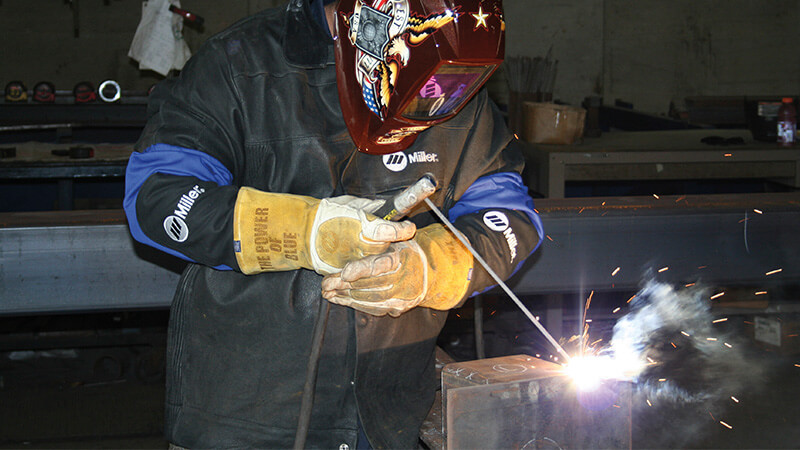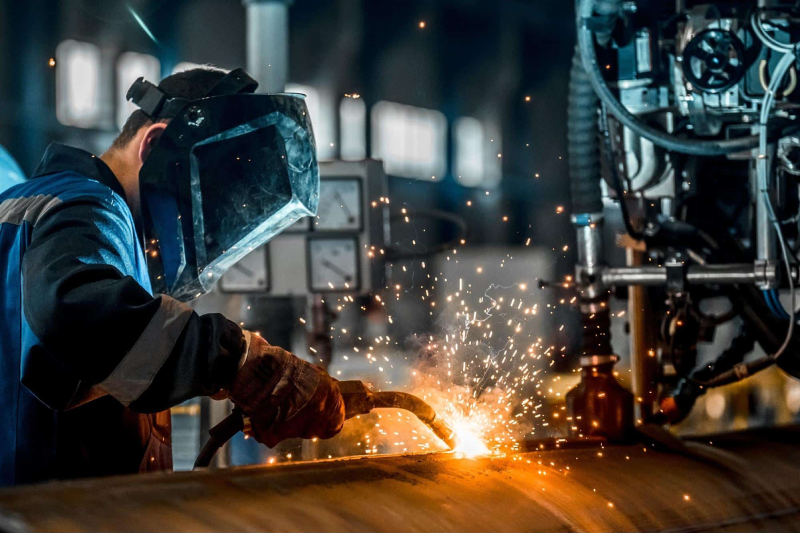Common Welding Fixing Issues and Exactly How to Address Them Efficiently
Welding repair services commonly encounter a series of issues that can endanger the stability of the final item. Usual problems include insufficient penetration, porosity, and imbalance, to name a few. Each issue offers distinct challenges that need details methods for resolution. Comprehending these problems is important for welders intending to enhance their end results and skills. This discussion will certainly discover these common welding repair problems and reliable approaches to address them.
Poor Penetration
Inadequate penetration occurs when the weld metal stops working to totally fuse with the base material, leading to weak joints and possible architectural failings. This issue frequently comes from insufficient warmth input, inaccurate electrode angle, or incorrect welding rate. Welders may come across insufficient penetration as a result of a mistake of the required parameters for a certain material density or type. In addition, contamination on the base product's surface area can impede reliable bonding, intensifying the trouble. To resolve inadequate penetration, welders must assure ideal setups on their devices and preserve a tidy work surface area. Routine inspection of welds is suggested to recognize any deficiencies early, enabling timely modifications and the prevention of endangered architectural stability in welded settings up.
Porosity
Porosity is a common defect in bonded joints that shows up as tiny gas bubbles trapped within the weld steel. This defect can endanger the integrity of the weld, resulting in reduced strength and possible failure under stress. Montana Mobile Welding and Repair Belgrade Fabrication. Porosity normally occurs from contamination, moisture, or improper welding techniques, which allow gases to run away into the liquified weld pool. To address porosity, welders must guarantee appropriate surface preparation, keep a clean working environment, and make use of ideal welding parameters. In addition, picking the right filler material and protecting gas can minimize gas entrapment. Routine examination and screening of welds can aid determine porosity early, ensuring timely rehabilitative actions are taken, consequently maintaining the top quality and integrity of the bonded framework
Imbalance
Imbalance in welding can occur from different variables, including inappropriate configuration and thermal growth. Comprehending the root causes is essential for reliable resolution. Numerous correction strategies are available to straighten parts and assure structural integrity.
Reasons for Imbalance
Welding imbalance often stems from a range of underlying problems that can jeopardize architectural honesty. One main cause is inappropriate fit-up of parts prior to welding, which can cause gaps and irregular surfaces. Variants in thermal expansion throughout the welding procedure can also result in distortion, particularly if the products being signed up with have different coefficients of development. In addition, inadequate fixturing and clamping might fail to hold parts securely in position, causing movement throughout welding. Poorly conserved tools, including welding machines and tools, might present incongruities in the weld grain, more adding to misalignment. Lastly, operator mistake, stemming from inadequate training or experience, can also play a considerable function in developing misaligned welds.
Improvement Methods Readily Available
Resolving imbalance effectively needs a combination of restorative techniques tailored to the details issues handy. One common technique is the use of fixtures or jigs to hold elements in the right placement throughout welding, guaranteeing regular alignment. Furthermore, preheating the materials can assist lower distortion and improve fit-up. For significant misalignment, mechanical adjustment strategies, such as making use of hydraulic jacks or clamps, can be utilized to deal with the placement prior to welding. Post-weld heat treatment may likewise be needed to eliminate tensions brought on by imbalance. Lastly, cautious evaluation and adjustment during the arrangement phase can avoid imbalance concerns from coming to be substantial issues, advertising a smoother welding process and enhancing total structural stability.
Distortion
Distortion is a common obstacle in welding that can arise from different elements, including irregular heating & cooling. Recognizing the reasons of distortion is essential for executing effective avoidance strategies. Addressing this concern not only improves structural stability yet also improves the general high quality of the weld.
Root causes of Distortion
When subjected to the extreme warmth of welding, products frequently undergo modifications that can bring about distortion. This sensation mainly occurs from thermal development and contraction during the welding procedure. Read Full Article As the weld location warms up, the product increases; upon air conditioning, it acquires, which can develop inner stresses. Additionally, irregular home heating throughout a additional hints workpiece can intensify these stress and anxieties, leading to warping or flexing. The kind of material also plays a considerable duty; steels with differing thermal conductivity and coefficients of growth might react in a different way, resulting in uncertain distortions. Inadequate joint design and poor fixturing can add to misalignment throughout welding, enhancing the probability of distortion. Recognizing these causes is vital for reliable welding repair work and avoidance methods.
Avoidance Techniques
Reliable avoidance strategies for distortion throughout welding focus on controlling heat input and guaranteeing proper joint design. Preserving a consistent warmth input assists to minimize thermal expansion and tightening, which can cause distortion. Using strategies such as pre-heating the workpiece can also minimize the temperature gradient, advertising uniform home heating. In addition, picking ideal joint layouts, such as T-joints or lap joints, can boost security and lower stress focus. Implementing appropriate fixturing to safeguard the workpieces in position better help in preserving alignment throughout the welding process. Staggered welding series can distribute warm more evenly, avoiding localized distortion. By using these strategies, welders can considerably decrease the likelihood of distortion and enhance the overall high quality of their welds.
Breaking
Fracturing is a common concern experienced in welding repairs, frequently resulting from various factors such as inappropriate cooling rates, material option, or insufficient joint preparation. The incident of splits can significantly compromise the stability of the weld, leading to possible failures during procedure. To resolve this issue, welders have to first assess the source, making certain that products work and suitably picked for the certain application. In addition, managing the air conditioning price during the welding procedure is vital; quick cooling can generate stress and anxiety and result in fracturing. Appropriate joint design and prep work also add to reducing the threat. Applying these methods can improve weld top quality and resilience, inevitably reducing the likelihood of cracking in completed weldments.

Insufficient Fusion
A substantial issue in welding repair services is insufficient blend, which happens when the Web Site weld steel does not adequately bond with the base product or previous weld passes - Belgrade Fabrication. This issue can cause weaknesses in the joint, possibly compromising the integrity of the bonded structure. Aspects adding to insufficient fusion consist of inadequate warmth input, inappropriate welding strategy, and contamination of the surfaces being joined. To resolve this issue properly, welders ought to guarantee correct pre-weld cleaning and surface prep work, in addition to readjust their welding parameters to attain appropriate penetration and blend. Normal examination during the welding procedure can also aid identify insufficient blend early, enabling for prompt rehabilitative measures to enhance the total high quality of the weld
Overheating
While welding repair services can improve structural integrity, overheating offers a significant obstacle that can bring about product destruction. Extreme warmth throughout welding can change the mechanical homes of metals, causing decreased strength, boosted brittleness, and warping. This phenomenon is especially vital in high-stress applications where architectural integrity is extremely important. Determining overheating can entail aesthetic examinations for staining or distortion, as well as checking temperature level during the welding procedure. To mitigate the risks related to getting too hot, welders need to use suitable strategies, such as managing warm input, adjusting traveling rate, and utilizing appropriate filler products. In addition, carrying out pre- and post-weld heat treatments can assist recover product buildings and boost the overall top quality of the fixing, ensuring long-term efficiency and safety.
Frequently Asked Concerns
What Are the Usual Indicators of a Welding Problem?

How Can I Test My Welds for Quality?
To check welds for quality, one can make use of aesthetic examinations, ultrasonic testing, and radiographic techniques. Each strategy assures structural stability, recognizes defects, and confirms adherence to specified standards, eventually enhancing the integrity of the bonded joints.
What Safety Precautions Should I Take While Welding?
When welding, one ought to prioritize safety and security by putting on ideal personal protective tools, guaranteeing correct ventilation, safeguarding combustible products away, preserving a clean work space, and recognizing environments to avoid injuries and accidents.
Can I Repair a Weld Without Remodeling the Entire Joint?
Repairing a weld without remodeling the entire joint is possible, depending on the damage (Welding). Methods such as grinding, including filler product, or making use of a welding procedure can effectively address specific defects while preserving the bordering structure
What Equipment Are Necessary for Reliable Welding Repairs?
Essential devices for efficient welding repairs consist of a welding maker, wire brush, mill, protective equipment, clamps, and filler materials. Each tool plays a crucial duty in guaranteeing high quality and security during the fixing procedure. Porosity typically develops from contamination, moisture, or incorrect welding techniques, which permit gases to leave into the liquified weld swimming pool. Poorly maintained devices, including welding machines and devices, might present inconsistencies in the weld bead, more adding to misalignment. When subjected to the extreme warm of welding, materials frequently undertake changes that can lead to distortion. Cracking is a common problem run into in welding fixings, commonly resulting from various factors such as improper cooling prices, product selection, or poor joint preparation. A significant issue in welding repairs is incomplete blend, which occurs when the weld metal does not effectively bond with the base product or previous weld passes.